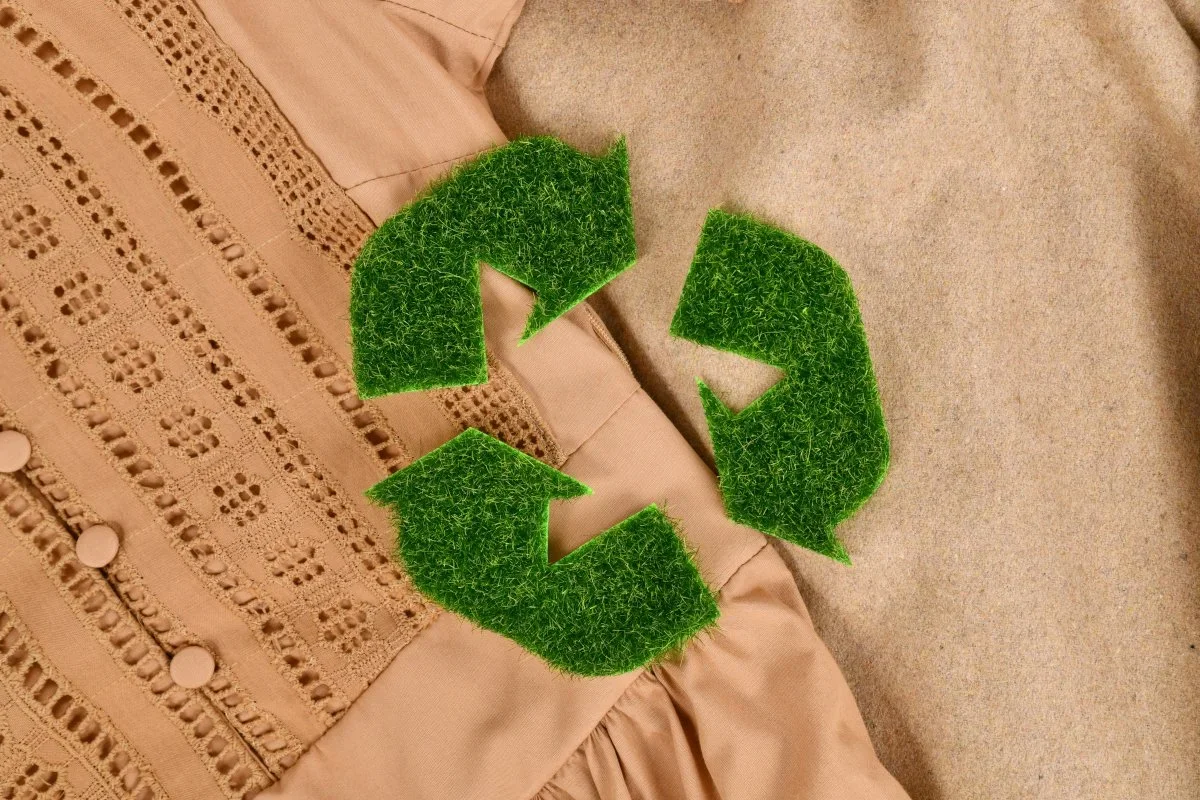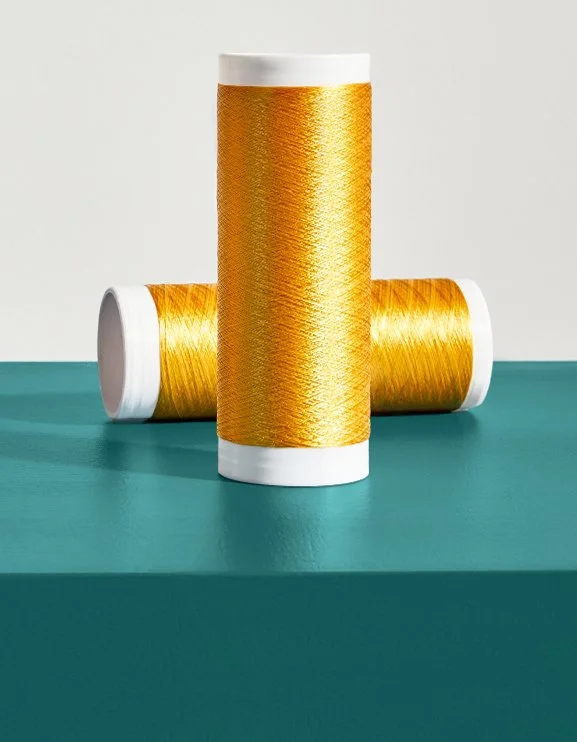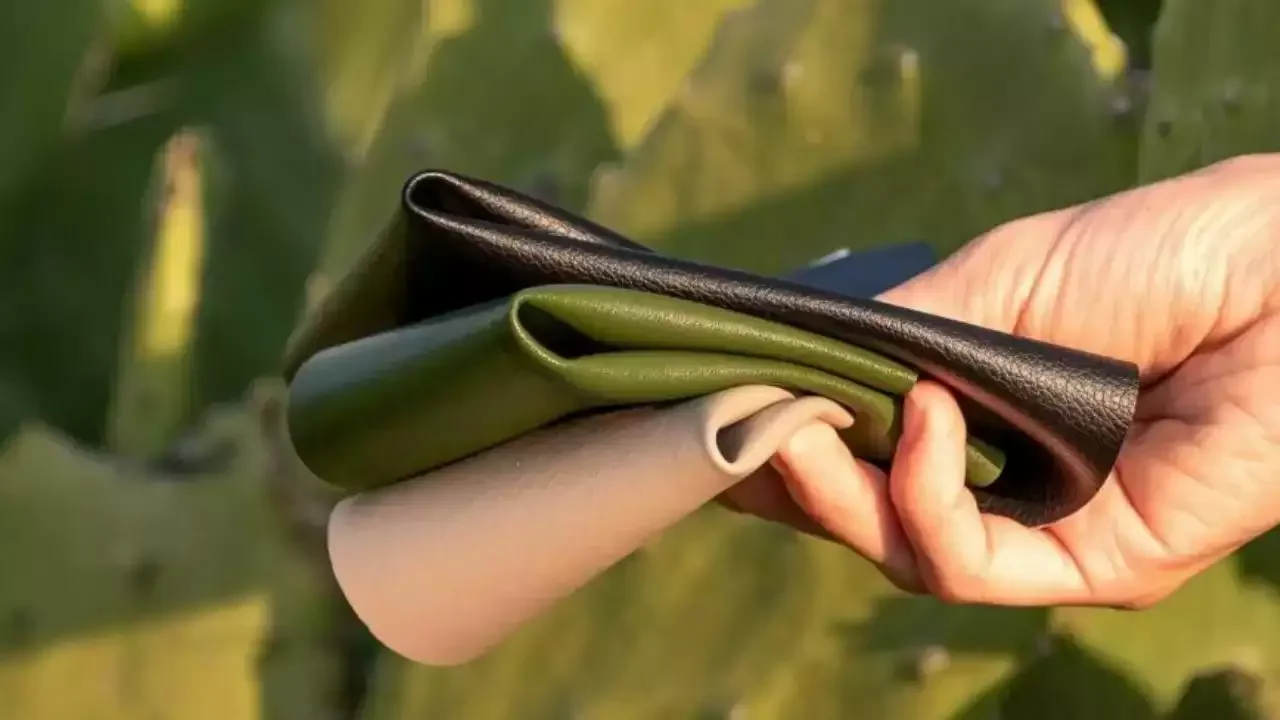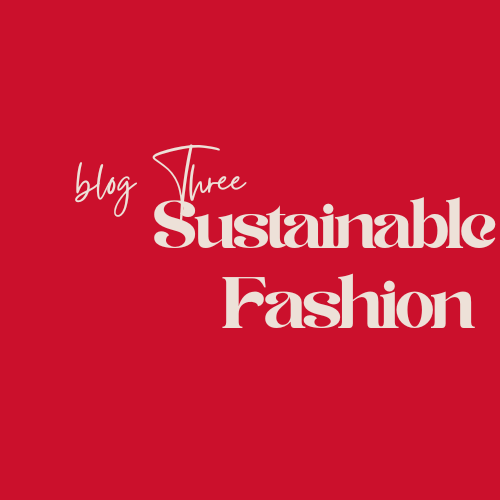Sustainable Fashion: Begins with Smart Fabrics
You might open your closet every morning and think about style — but have you ever stopped to think about science? The next fashion revolution isn’t happening on the runway, but it’s happening in the fibers that put our favorite pieces together. From silky blouses to buttery-soft leggings, every thread tells a story. The question is: what kind of story do you want yours to tell? Fashion used to be defined by how it looked, but now, it’s defined by how it’s made. More consumers are asking questions. Where did this come from? What is it made of? Was it created responsibly? The answers are in a growing movement that puts together innovation, ethics, and beauty — fabrics that are smart, sustainable, and kind to the planet.
Recycle logo on a piece of clothing.
Image via Sustain Your Style
The Pain Point: Fashion Needs a Makeover — From the Inside Out
For decades, the industry has been focused on aesthetics and trends — bold prints, flattering cuts, and seasonal must-haves. But behind the shimmer, traditional textiles often hide an uncomfortable truth:
Microplastics shed from synthetic fibers end up polluting oceans.
Toxic dyes and chemical finishes harm ecosystems.
Animal-derived leathers and furs raise ethical questions.
The modern shopper wants more than fast fashion and fleeting trends. Today’s fashion-forward audience craves transparency, innovation, and purpose. The challenge — and opportunity — for brands is to design clothing that satisfies both style and substance. That’s where the new wave of smart and sustainable fibers enters the scene.
Sustainable Fashion Benefits.
Image via theVOU
Breakthroughs in Modern Materials
1. Lab-Grown Fibers: Science Meets Style
In a world searching for sustainable silk, Bolt Threads introduced Microsilk®, a lab-grown fiber inspired by spider silk. Spiders produce silk that’s five times stronger than steel, lightweight, and biodegradable. Scientists replicated this process using fermentation technology, blending natural proteins with yeast to create a luxury textile without relying on traditional silkworms.
The result? A material as soft as silk but made without harming animals or ecosystems. Microsilk was first showcased in a partnership with Stella McCartney, whose designs embody eco-luxury. The fabric behaves like traditional silk but with futuristic benefits — it’s renewable, versatile, and planet-friendly.
Bolt Threads Microsilk.
Image via Bolt Threads
2. Regenerated Yarns: Fashion’s Recycling Revolution
If you’ve ever walked along the beach and seen bits of plastic tangled in seaweed, you’ve glimpsed fashion’s next raw material. Econyl®, developed by Aquafil, transforms discarded fishing nets, industrial waste, and ocean plastics into luxury-grade nylon.
This process is called regeneration, and it’s revolutionizing the supply chain. Econyl isn’t “downcycled” — it’s reborn. The recycled nylon has the same quality and durability as virgin nylon but with up to 90% fewer carbon emissions.
Major fashion houses have embraced it:
Prada now uses Econyl in its Re-Nylon collection.
Gucci integrates it into accessories and outerwear.
Adidas has released sneakers featuring Econyl yarn.
These collaborations show that circular fashion is not only possible — it’s profitable.
Prada Nylon Bag shown in fashion.
Image via Camila Coelho
3. Smart Fabrics: Your Closet Just Got Smarter
Imagine a jacket that senses a chill in the air and adjusts its insulation. Or a yoga set that tracks your posture and heart rate. These ideas are no longer science fiction.
Smart fabrics are merging wearable technology with everyday fashion. Using sensors, conductive fibers, and reactive coatings, these textiles can:
Regulate temperature by expanding or contracting in response to heat.
Monitor physical activity, heart rate, or posture.
Change color under UV light for protection and personalization.
Brands like Wearable X and Ministry of Supply are at the forefront of this trend. While still niche, smart textiles signal a future where your clothes are not only stylish — they’re interactive.
Examples of smart fabric textiles.
Image via MDPI
4. Vegan Leathers: Nature’s New Luxury
For years, leather symbolized luxury — but also sparked debate. Now, a wave of plant-based alternatives is redefining what it means to go “leather.”
Piñatex® (from pineapple leaves) offers a supple, durable surface used by H&M and Hugo Boss.
Mylo® (crafted from mushroom mycelium) has been adopted by Stella McCartney for handbags and sneakers.
Desserto® (made from cactus fibers) is lightweight, water-efficient, and free from harmful PVC.
These bio-based leathers use agricultural byproducts and require less water, no animal cruelty, and lower carbon emissions. Beyond sustainability, they appeal to fashionistas who love the tactile feel of luxury without the ethical compromise.
Bio based leathers.
Image via World Bio Market Insights
From Runway to Reality: Case Studies in Action
Prada Re-Nylon Project: A bold step toward circular fashion, Prada’s entire nylon line is now produced using regenerated Econyl yarn. This move demonstrates that sustainability and status can coexist — turning recycled waste into a luxury statement.
Stella McCartney’s Mylo Bag: In 2021, Stella debuted the world’s first handbag made from Mylo mushroom leather. It showcased how fashion houses can lead innovation while staying true to their eco-ethos.
Adidas x Parley Collaboration: Adidas created sneakers and athletic wear from upcycled ocean plastic. The result? Over 30 million pairs sold, proving consumers are willing to invest in sustainability when it looks good.
These examples show a shift from trend to transformation — a movement where materials matter.
Adidas x Parley sneaker made from upcycled plastic.
Image via Parley
Fur and Leather: A Changing Landscape
While innovation thrives, so does introspection. Traditional fur and leather, once symbols of status, now face scrutiny.
Fur bans in cities like Los Angeles and brands like Gucci, Versace, and Burberry signal changing values.
Vegan leathers and faux furs crafted from recycled polyester or plant fibers now offer warmth and glamour without harm.
Consumers no longer see fur as a luxury, but as a choice — one many are opting out of.
This evolution proves one thing: luxury is being redefined. The new prestige lies in purpose, not pelts.
Many protesting against furs.
Image via CNN
Why It Matters
For Fashion Lovers: You can embrace trends without compromising values.
For Designers: Innovation is your competitive edge; the materials you choose tell your brand’s story.
For the Planet: Every sustainable choice reduces waste, emissions, and harm.
Today’s textile revolution empowers consumers and creators alike to dress beautifully and consciously.
How to Shop Smarter: Your Fabric Label Checklist
When you’re browsing your favorite boutique or scrolling through an online drop, take a quick peek at the fabric composition tag — it’s your fashion nutrition label. Look for:
Recycled Nylon (Econyl®) — signals circular production.
Bio-Based or Lab-Grown Fibers (Microsilk®) — engineered for sustainability.
Plant Leathers (Piñatex®, Mylo®) — cruelty-free alternatives.
Organic Cotton or Hemp — low-impact, renewable resources.
Smart Textiles — for adaptive, high-performance wear.
Small switches lead to a big impact. Fashion is a language — and what you wear can speak volumes about what you stand for.
Woman looking at clothes and details off a clothing rack.
Image via Total Image Consultants
Fashion Forecast: Sustainability Is the New Status Symbol
Tomorrow’s tastemakers will flaunt values, not just logos. Owning a coat made from mushroom leather or a handbag crafted from fishing nets says, “I care about what I wear.”
This is where art meets innovation, where science, ethics, and aesthetics are woven together. The result? A fashion future that feels responsible, aspirational, and alive.
The next time you slip into your favorite outfit, ask yourself — what story does this fabric tell? Because in the future of fashion, style begins with substance.
References
Aquafil. (n.d.). Econyl® regenerated nylon: Sustainable innovation for a circular future. Retrieved October 6, 2025, from https://econyl.aquafil.com
Bolt Threads. (2024). Microsilk: Inspired by nature, engineered for performance. Retrieved October 6, 2025, from https://boltthreads.com/technology/microsilk
Camila Coelho. (2024). Prada Re-Nylon bag shown in fashion. Retrieved October 6, 2025, from https://camilacoelho.com
Canva. (2025, October 7). Canva.com.
Chatgpt. (2025, October 7). Chatgpt.com.
CNN. (2024). Protesters march against the use of fur in fashion. Retrieved October 6, 2025, from https://www.cnn.com
MDPI. (2024). Examples of smart fabric textiles. Retrieved October 6, 2025, from https://www.mdpi.com
Parley for the Oceans. (2024). Adidas x Parley sneaker made from upcycled plastic. Retrieved October 6, 2025, from https://www.parley.tv
Sustain Your Style. (2024). Recycling logo printed on a piece of clothing. Retrieved October 6, 2025, from https://www.sustainyourstyle.org
theVOU. (2024). Chart of benefits from sustainable fashion. Retrieved October 6, 2025, from https://thevou.com
Total Image Consultants. (2024). Woman looking at clothes and details off a clothing rack. Retrieved October 6, 2025, from https://totalimageconsultants.com
World Bio Market Insights. (2024). Man holding bio-based leathers made from plants. Retrieved October 6, 2025, from https://worldbiomarketinsights.com










